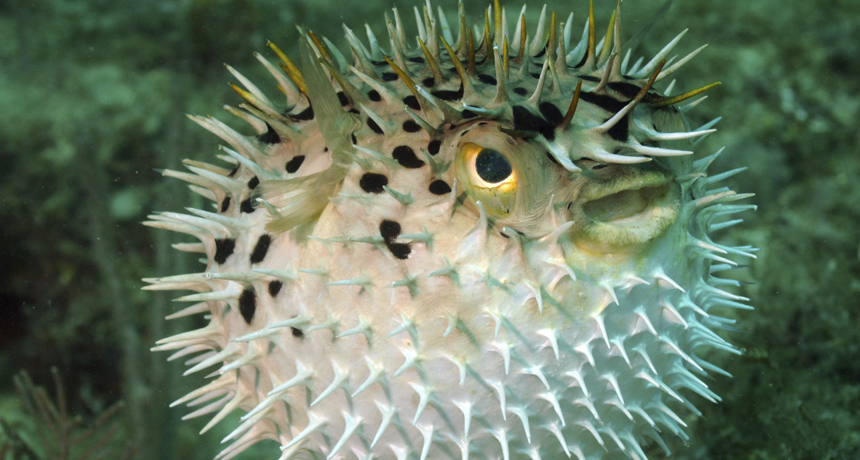Look ma — no stomach
Genes point to how some fish and other animals lost this digestive organ

Pufferfish, like this one, lost its digestive stomach. That organ has a new purpose now: holding food and scaring predators.
FtLaudGirl/iStockphoto
By Susan Milius
Losing your stomach sounds much worse than just losing your lunch. But maybe it’s not.Just don’t lose that stomach fast.
Two things make a true stomach, explains Filipe Castro. (He’s a biologist who studies evolution at the University of Porto in Portugal.) A true stomach can make a very strong acid. That acid helps trigger the breakdown of meals. But a true stomach also releases chemicals called pepsins. Able to work well in very acidic places, these enzymes slice and dice apart proteins in tissues such as meat.
So a stomach would seem a very useful organ for any animal that eats big or complex meals. Yet over the years — probably many, many millions of years — a large number animals have lost their stomachs. Examples range from the platypus and ghost shark to the lungfish. A team of scientists wanted to probe how such animals evolved to live without these meal digesting organs. Their first step: They looked at the animals’ genes.
The researchers focused on 14 various vertebrates — animals with backbones —comparing the genes in those with and without stomachs. In the December 4 Proceedings of the Royal Society B, Castro and his team now report finding a distinct difference between them. No stomach-free animal had genes to produce an acid-rich zone in its digestive tract. Animals without stomachs also lacked genes (or had low-functioning ones) to produce pepsin.
Animals without stomachs still digest their meals — just in a different way. The rest of their plumbing, for instance, may do extra work.
True stomachs evolved in vertebrates, explains Castro. Some 450 million years ago, glands that make food-breakdown chemicals began developing in what would become stomachs. Since then, he notes, such glands have been lost at least 15 separate times across the animal tree of life.
Today, more than one in every four bony fishes digest its food without a true acid-making stomach. Picking out what drove this evolutionary change is tricky, notes coauthor Jonathan Wilson. Some no-stomach animals eat meat. Some just eat plants. And certainly, what any of them eats now could be different from what its ancestors ate when their stomachs first began their disappearing act, millions of years ago.
Over that time, stomachs in some animals have even evolved new jobs. Those in the pufferfish, for instance, now store food. These fish can also make their former stomachs bloat with water so the critter swells up and its spines stick out. Its goal: to make it look unappetizing.
Power Words
acid A chemical that increases the level of hydrogen ions in a solution.
digest (noun: digestion) To break down food into simple compounds that the body can absorb and use for growth. Some sewage-treatment plants harness microbes to digest — or degrade — wastes so that the breakdown products can be recycled for use elsewhere in the environment.
enzyme Molecules made by living things to speed up chemical reactions.
evolve To change gradually over generations, or a long period of time. In living organisms, the evolution usually involves random changes to genes that will then be passed along to an individual’s offspring. These can lead to new traits, such as altered coloration, new susceptibility to disease or protection from it, or different shaped features (such as legs, antennae, toes or internal organs).
gastric An adjective describing things related to the stomach.
gland A cell, a group of cells or an organ that produces and discharges a substance (or “secretion”) for use elsewhere in the body or in a body cavity, or for elimination from the body.
gene A segment of DNA that codes, or holds instructions, for producing a protein. Offspring inherit genes from their parents. Genes influence how an organism looks and behaves.
muscle A type of tissue used to produce movement by contracting its cells, known as muscle fibers. Muscle is rich in a protein, which is why predatory species seek prey containing lots of this tissue.
proteins Compounds made from one or more long chains of amino acids. Proteins are an essential part of all living organisms. They form the basis of living cells, muscle and tissues; they also do the work inside of cells.Among well known stand-alone proteins: the hemoglobin in blood and the antibodies that attempt to fight infections.Medicines frequently work by latching onto proteins.
predator (adjective: predatory) A creature that preys on other animals for most or all of its food.
vertebrate An animal that has a long backbone or spinal column. Vertebrates include mammals, birds, reptiles, amphibians and fish.







